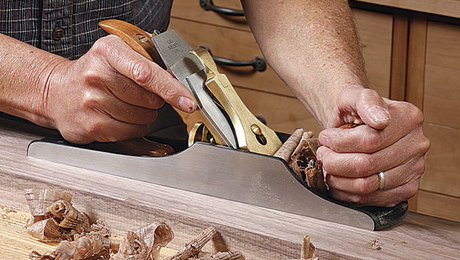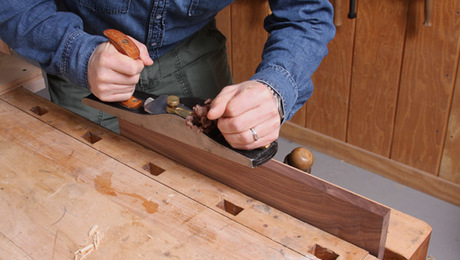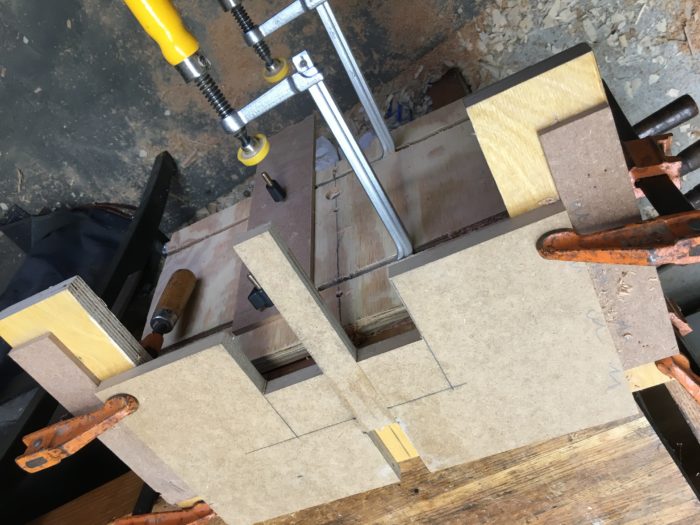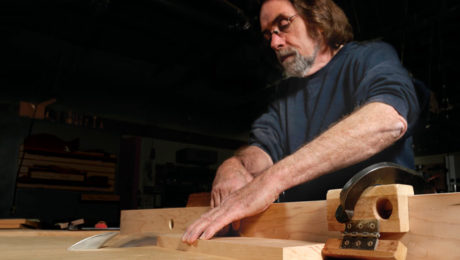STL220: Jack plane death match – Will bevel up go down?
Mike, Barry, and Ben discuss jack planes, tablesaw safety, scrap wood storage, and how a listener could widen dadoes. |
Question 1:
From Brad:
I have come to the realization I may have a wood scrap hoarding problem. I have several boxes where I have separated out general construction lumber, cherry, and walnut scraps. I’ll keep some scraps with the rationalization that I can turn it into something on the lathe, so it seems that no scrap is too small. Granted, I have found myself on occasion digging through a box looking for something in particular but it’s not a great storage situation. What is your keep/trash threshold? Any good storage ideas?
 |
A Smart Cart for ScrapsJUNE 22, 2012 |
Question 2:
From Rob:
I’m a huge fan of your podcast — it converted me into a FWW subscriber.
I’m new to woodworking and I’m trying to build up my essential tools. I know a #5 bench plane is on most people’s list of the three essential hand planes. However, I see a lot of people praising low-angle, bevel-up jack planes as versatile, good for shooting and easy to use on gnarly wood. Should a new woodworker start with a low-angle plane or a #5? Am I missing some major difference in their capabilities? Is a #5 easier to tune up and maintain?
Mike mentioned Bill Ritner’s replacement knobs and totes for old Stanley planes.
 |
|
 |
|
 |
|
Segment: Potpourri!
Barry – Tailing the wrong end of his timber-frame style workbench stretcher.
 |
Ben –
Tool – Stew Mac Tape Deck
Technique – Stealing Mike Korsak’s method for making flawless routing templates
 |

Mike – His A/C in his shop, and a 3/16-in. spacer block for double tenons
Question 3:
From Matt:
I have a large cross cut sled with a slot built into the fence which allows me to have an adjustable stop block. But with long boards I often use the fence as a stop to get consistent lengths. On a scale from 1 – begging for a trip to the ER, where does this land? I have a 5-hp table saw and little woodworking experience. My fence is as close to perfectly parallel to the blade as I can measure. I try to ensure my board does not rock from the fence so as to not pinch the blade and cause kickback. I have used this method about 75 times but I would love your input.
 |
So you just bought a tablesawA collection of articles and videos that will teach you the important things to know before operating a tablesaw. |
 |
Question 4:
From Stephen:
I need a sure fire approach to widening a long dado in sheet goods. I’m in the process of making a small bookshelf from shop-sawn walnut veneer on Baltic birch. I’m using dadoes to fit shelves. In cutting the dadoes on the table saw, at some point the fence must have moved (idk, really, just I messed up) but some dadoes in the case sides are a fat 32nd of an inch too narrow to fit the BB 1/2 shelves. Case is 14” deep. What is the best way to widen these dadoes?
I have some hand tools, but nothing obvious came to mind to leave a nice straight line where the shoulder of the dado meets the shelf. Afraid getting the table saw dialed in to remove the little material may lead me down a worse path. Thanks everyone for any help
Listener Comments:
From Aled Pough on IG:
I’ve just listened to the latest episode of STL around the European dado blade question. It’s getting a bit geeky, but technically dado blades are legal, but there are two bits of legislation that make it difficult.
One regulation stipulates that a saw blade must stop within 10 seconds of being stopped. This is difficult for most (of our) saws to achieve with a loaded dado stack. Most saws come with a short arbour to prevent stacks being added.
The other regulation is that the blade must be guarded at all times and in the uk blade guards are almost universally attached to the riving knife and so you would need a floating guard to replace it.
Every two weeks, a team of Fine Woodworking staffers answers questions from readers on Shop Talk Live, Fine Woodworking‘s biweekly podcast. Send your woodworking questions to shoptalk@taunton.com for consideration in the regular broadcast! Our continued existence relies upon listener support. So if you enjoy the show, be sure to leave us a five-star rating and maybe even a nice comment on our iTunes page.





















Comments
Another great podcast. Every time I listen to one of these I discover I need something else for my shop. As a result of this one I need a multi roll tape dispenser and a new saw blade that Mike recommended but I wasn’t clear on what box joint blade he was referring to. I’m assuming it’s one of the Forrest blades but not sure which one. Help on that would be appreciated. Thanks.
Haha I paused the podcast to research the finger joint blades. Also have been researching dado planes. Is this episode divine intervention? it is if I must acquire another tool...
So, what’s a paring block anyway?
Very little google info (and NO videos) on what this “well known to the FWW team” tool is, how to make/buy, and how to use?
Enlighten us,please?
Any of Mike's kumiko videos feature paring blocks. Also, Matt Wajda uses one here: https://www.finewoodworking.com/2017/03/14/ep-9c-dovetailed-divider
Can Mike tell us where he gets his tiny pattern router bits?
I can’t believe all the discussion on widening the dado by 3/16. Put a piece of sticky back sandpaper on the edge of a board narrower than the dado and slide it back and forth. This will solve the problem whether the dado is uneven or consistently narrow.
Log in or create an account to post a comment.
Sign up Log in